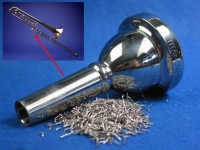Cutting-edge research in titanium

An Edinburgh Team led by Prof Graeme Ackland has discovered that at extreme shear rates, metals can melt: this "shear melting" is well known in colloids and soft solids, but almost unachievable in alloys. For pure titanium shear rates would be well beyond modern machining capability.
Titanium is hard to break. For applications, this is its big advantage, but for manufacturing it is a problem. In a lathe the waste material forms a long unbroken spiral chip which clogs the machine. The goal is to create an alloy that breaks easily in machining, but not in use.
An Edinburgh team led by Prof Graeme Ackland has discovered that at extreme shear rates, metals can melt: this "shear melting" is well known in colloids and soft solids, but almost unachievable in alloys. For pure titanium, shear rates would be well beyond modern machining capability.
To facilitate "shear melting", titanium could be mixed with an element which lowers the melting point. Typically, this would weaken the alloy, so the team chose something that does not dissolve: a rare earth metal (REM). REMs form small inclusions in the alloy under normal conditions, leaving its properties intact, but cutting breaks these inclusions releasing the REM into the alloy. In a feedback effect, cutting releases the rare REM, allowing shear melting which enables further fracture until the chip breaks.
The group of Carsten Siemers in Braunschweig has created the alloy, and in machining tests show that it does indeed break off in small pieces. The company GfE is now looking to develop it commercially.
The most likely applications for the alloy are where we can replace steels (which are heavy) or aluminium (which is soft). One company has already made a batch for use in trial applications in dental tool couplings and mouthpieces for brass instruments. In fact my collaborator in Braunschweig is a trombonist and has tested one of the mouthpieces.
Physical Review Letters paper
The work was supported by the EU "MAMINA" training network, and is reported this month in Physical Review Letters:
"Shear melting and high temperature embrittlement: theory and application to machining titanium". Con Healy, Sascha Koch, Carsten Siemers, Debashis Mukherji and Graeme J Ackland, Physical Review Letters, April 2015

